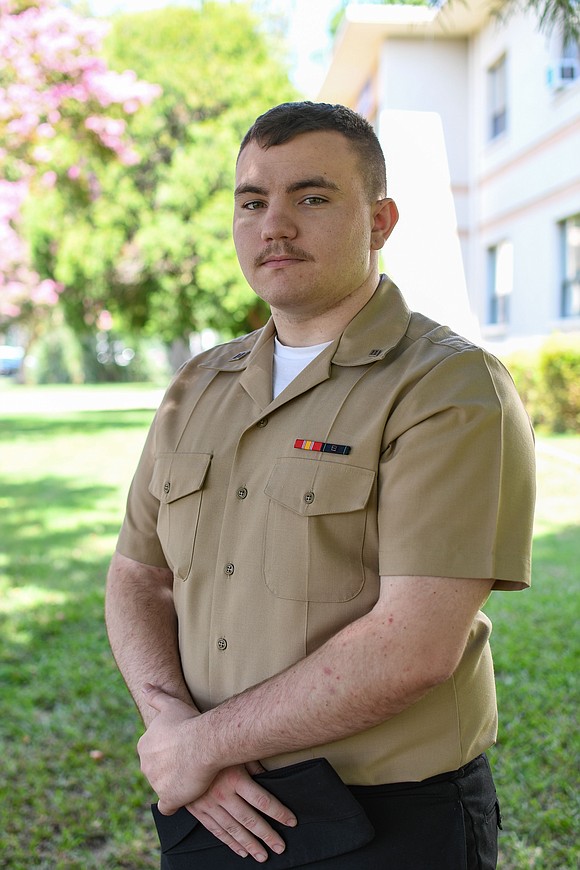Houston native serves aboard U.S. Navy’s East Coast Master Jet Base
Style Magazine Newswire | 9/12/2022, 3:52 p.m.
By Stephanie Fox, Navy Office of Community Outreach
Virginia Beach, Va. – Airman Hunter Fahy, a native of Houston, Texas, serves the U.S. Navy assigned to Naval Air Station Oceana.
Fahy joined the Navy two years ago.
“I come from a military family, so I grew up wanting to serve my country,” said Fahy. “My dad, grandpa, great grandpa, uncles and cousins have all served. I wanted to do my part to protect and defend our nation as well."
Growing up in Houston, Fahy attended St. Pius X High School and graduated in 2018. Today, Fahy relies upon skills and values similar to those found in Houston to succeed in the military.
“My hometown taught me the value of hard work,” said Fahy. "If you work hard you can get any job done. That's a helpful mindset to have in the Navy because it's allowed me to work hard to gain qualifications to do my job. It's kept me out of trouble."
These lessons have helped Fahy while serving with Naval Air Station Oceana.
Naval Air Station Oceana serves as the Navy’s East Coast Master Jet Base. The flight line, Apollo Soucek Field, is home to 17 aviation squadrons, and hosts the F/A-18 Super Hornet.
The Super Hornet is one of the most advanced aircraft in the world, according to Navy officials. The aircraft takes off from and lands on Navy aircraft carriers at sea and is capable of conducting air-to-air combat as well as striking targets on land.
Navy aircraft carriers are designed for a 50-year service life. When the air wing is embarked, the ship carries more than 70 attack fighter jets, helicopters and other aircraft, all of which take off from and land aboard the carrier at sea. With more than 5,000 sailors serving aboard, the aircraft carrier is a self-contained mobile airport.
Aircraft carriers are often the first response to a global crisis because of their ability to operate freely in international waters anywhere on the world’s oceans.
Since USS Langley's commissioning 100 years ago, the nation's aircraft carriers and embarked carrier air wings have projected power, sustained sea control, bolstered deterrence, provided humanitarian assistance and disaster relief, and maintained enduring commitments worldwide.
"The aircraft carrier is our U.S. Navy's centerpiece, our flagship, and a constant reminder to the rest of the world of our enduring maritime presence and influence," said Rear Adm. James P. Downey, USN, Program Executive Officer (PEO) Aircraft Carriers. "These ships touch every part of our Navy's mission to project power, ensure sea control, and deter our adversaries."
Serving in the Navy means Fahy is part of a team that is taking on new importance in America’s focus on strengthening alliances, modernizing capabilities, increasing capacities and maintaining military readiness in support of the National Defense Strategy.
“The Navy contributes to the National Defense Strategy by protecting our interests,” said Fahy. "We guarantee the safety of our citizens through our power projection. We're a show of force."
With more than 90 percent of all trade traveling by sea, and 95 percent of the world’s international phone and internet traffic carried through fiber optic cables lying on the ocean floor, Navy officials continue to emphasize the importance of accelerating America’s advantage at sea.
“Maintaining the world’s best Navy is an investment in the security and prosperity of the United States, as well as the stability of our world,” said Adm. Mike Gilday, Chief of Naval Operations. “The U.S. Navy—forward deployed and integrated with all elements of national power—deters conflict, strengthens our alliances and partnerships, and guarantees free and open access to the world’s oceans. As the United States responds to the security environment through integrated deterrence, our Navy must continue to deploy forward and campaign with a ready, capable, combat-credible fleet.”
Fahy and the sailors they serve with have many opportunities to achieve accomplishments during their military service.
“Joining the military has been a dream of mine since I was a child,” said Fahy. "I'm proud to finally make that dream come true. And I've gotten to meet a lot of cool people along the way."
As Fahy and other sailors continue to train and perform missions, they take pride in serving their country in the United States Navy.
“I feel as though everyone has a duty to their country and home in some fashion,” added Fahy. "Everyone should contribute in some way. My way is through my military service."
For more info, visit Navy Outreach.




